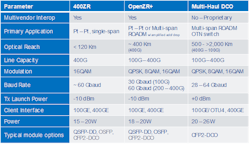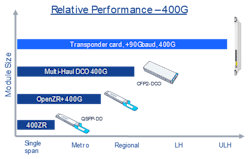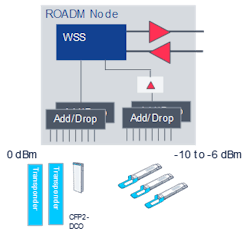The introduction of 100G coherent optical interfaces in 2010 dramatically expanded network capacity, while at the same time lowering the cost per bit for optical networks. Since then, ongoing improvements in optical technology and coherent DSPs have resulted in wavelength capacities increasing from 100G to over 600G per wavelength. New generations of multi-modulation, multi-baud rate transponders enable flexible WDM line interfaces with capacities close to Shannon limits on every optical route (Figure 1).
Since achieving near Shannon limits on performance, much of the recent industry focus has shifted to expanding capacity by using C+L WDM line systems, along with developing pluggable coherent optics to meet growing capacity needs in metro-based data center interconnect (DCI) and cloud applications. While still early in development, new 400ZR, OpenROADM, and OpenZR+ interface specifications enable WDM line interoperability, so carriers can mix and match coherent interfaces from different vendors across their networks.
Comparing the Options – 400ZR/OpenZR+/Multi-Haul
The great thing about industry “standards” is there are so many choices available. Currently, several coherent interface specifications have been issued, or are in varying phases of development, including 400ZR, OpenZR+, OpenROADM, and CableLabs P2P. In addition, vendors continue to develop their own proprietary high-performance modes, generically referred to as “400ZR+” or “Multi-Haul DCO” modes.
Developed by the Optical Interoperability Forum (OIF), the 400ZR specification was one of the first efforts to define an interoperable 400G coherent interface. Released in March 2020, the OIF 400ZR Implementation Agreement defines a 400G coherent interface for use on point-to-point links up to 120 km. The 400ZR target applications include interconnecting local data center caching sites to metro point of presence (POP or backhaul) offices and interconnecting multiple data centers across metro areas.
A key objective was to ensure 400ZR modules were both cost and size optimized for their intended point-to-point applications and relatively modest distances (<120 km). These goals were achieved by limiting the 400ZR performance specifications to ensure the power consumption fit within smaller-sized-module thermal limits, which also enabled using more cost-effective, moderate performance components within the modules. As of Q3 2020, 400ZR modules are available for demonstration and vendor platform integration, with full availability expected in early 2021.
With the OIF 400ZR efforts focused on a single modulation type and line rate (400G) for metro point to point applications, the OpenZR+ and OpenROADM groups focused on higher-performance optical specifications capable of flexible 100G – 400G line rates and longer optical reaches. The recently issued OpenZR+ Multi-Source Agreement provides interoperable 100G, 200G, 300G, and 400G line rates over metro, regional, and long-haul distances, based on a new frame structure utilizing OpenFEC (oFEC) forward error correction and a set of 100-400G optical line specifications. Performance estimates over standard SMF-28 fiber (EDFA only), and under ideal network assumptions, are up to 480 km in 400G mode. When operating over real world networks with varying span distances, 75-GHz channel widths, intermediate ROADM nodes, and allocating ~2 dB spare margins to accommodate component aging, temperature variation, component variance, polarization dependent loss (PDL), polarization mode dispersion (PMD), and nonlinearity impairments, 400G optical reaches are more likely to be in the 300- 400 km range over standard SMF-28 fiber (EDFA only).
Even higher performance modules are currently under development, referred to as the “Multi-Haul DCO” category. These higher-performance, proprietary modules generally use slightly larger module sizes (CFP2-DCO), higher performance SD-FECs, higher transmit (Tx) launch powers, and high-performance frontend optical components (drivers, transimpedance amplifier, modulators, lasers) to achieve longer optical reaches. At least for now, these higher-performance modules and operating modes remain proprietary to each vendor (Table 1).
The 400ZR and OpenZR+ specifications were primarily developed to meet the growing capacity requirements of DCI and cloud operators using 100GbE/400GbE client interfaces. For carriers needing to transport OTN client signals (OTU4), OpenROADM and Multi-Haul DCO optical pluggables offer good alternatives, as they support both Ethernet and OTN client signals.
Module Size is Not Defined
One of the biggest misconceptions with the new 400ZR and OpenZR+ specifications is that these interfaces are based on QSFP-DD modules, which is not accurate. The new 400ZR and OpenZR+ agreements are “line interface specifications” providing interoperability of the line interface; they do not define or specify the size or type of pluggable module (i.e., box size).
While efforts were made in the 400ZR specifications to ensure the performance and power consumption limits fit within smaller module sizes, 400ZR interfaces will be available across a wide array of QSFP-DD, OSFP, and CFP2-DCO modules. Networks can operate using 400ZR interfaces with different modules sizes at each end, as the “box size” doesn’t matter from a line interface interoperability standpoint.
For 400ZR applications, the QSFP-DD module size is projected to be the high-volume leader, due to lower pricing and smaller footprint, compared to the other module size options. Regional and long-haul applications may be better suited for slightly larger module sizes for performance reasons.
Size Matters
While the size of the pluggable module doesn’t affect interoperability, it can have a significant impact on optical reach and capacity performance. As mentioned previously, the 400ZR specifications were purposely limited to ensure the module power consumption fit within the thermal limits of smaller sized pluggable modules (QSFP-DD). For metro point-to-point applications (<120 km), the 400ZR performance limitations are a desirable tradeoff to achieve smaller, lower-cost coherent modules while still meeting their intended DCI application requirements.
For OpenZR+ and Multi-Haul optical interfaces, where the optical modules support flexible 100G – 400G line rates and are intended to be used over metro, regional, and long-haul networks, the pluggable module size can have an impact on the overall optical reach.
A number of design techniques are used to ensure coherent optics fit within the thermal limits of a particular module size, including:
- using slightly less powerful FECs with fewer FEC iterations
- limiting chromatic dispersion (CD) compensation
- lowering Tx launch power.
While these techniques are needed to fit into the smallest module sizes (QSFP-DD), they also limit the performance compared to larger CFP2-DCO modules or card-based transponders.
In regional and long-haul networks, wavelengths are limited by their optical signal-to-noise ratio (OSNR) performance. For every capacity, modulation, and baud-rate combination there is a minimum OSNR required at the far-end receiver to ensure error-free operation. As a wavelength travels down a fiber, the OSNR degrades due to the combined fiber span losses, amplifier noise (ASE), and nonlinear effects, until the OSNR limit is eventually reached (Figure 2).
Comparing the Tx launch power and OSNR values of smaller-sized modules provides a good example of how module size affects performance. To limit power consumption, both 400ZR and OpenZR+ specifications reduce Tx launch powers to as low as -10 dBm, resulting in a Tx OSNR of approximately 34 dBm. A coherent CFP2-DCO module or card-based transponder provides approximately 0 dBm Tx power and approximately 44 dB Tx OSNR. Since it is the ONSR that ultimately limits a wavelength’s optical reach, the highest performance is achieved by using optics with higher OSNR values at the starting point. The wide array of module sizes and module performance allows for optimization of across different target applications (Figure 3).
WDM Node Effects
The lower Tx power on smaller-sized pluggables does have an impact on node architectures. Most WDM systems require approximately -2 to +2 dBm input power at the client-side add/drop ports for proper operation. The lower input powers from coherent QSFP-DD modules will need to be boosted, either by some type of external amplification prior to the WDM node or by using additional amplifiers within the WDM node add/drop stage, as shown in Figure 4.
Coherent Pluggables Benefits
Increasing capacity requirements in metro-based DCI and cloud applications are driving industry demand for interoperable, pluggable coherent modules that promise improved cost efficiencies and operational benefits, along with the ability to mix and match modules from different vendors. A wide array of new coherent interface specifications, including 400ZR, OpenZR+, and OpenROADM have been developed to meet these new applications. While the “box size” isn’t usually specified in the line interface agreements, QSFP-DD is expected to be a very popular module size for 400ZR optics, with slightly larger modules and card-based transponders better suited for higher performance long-haul applications.
Randy Eisenach is part of the WDM and High Speed Optics Product Management team at Nokia. He specializes in optical transport technologies, next generation ROADM architectures, and high-speed photonics.
Randy has over 30 years of optical transport and networking experience and has held a wide range of senior level positions in systems engineering, product management, and product marketing. He has authored several papers and spoken at many industry conferences.
Randy has a Bachelor of Science degree in Electrical Engineering from Purdue University (BSEE ’83).





